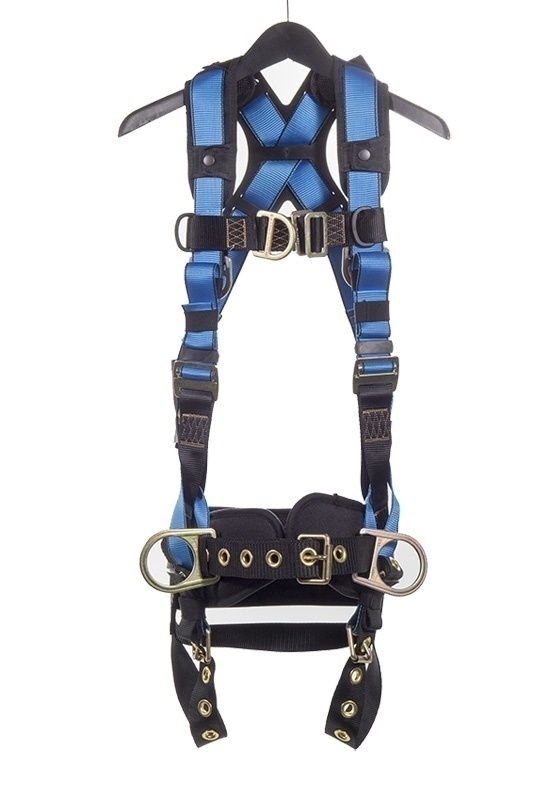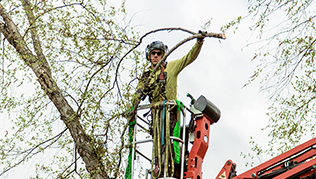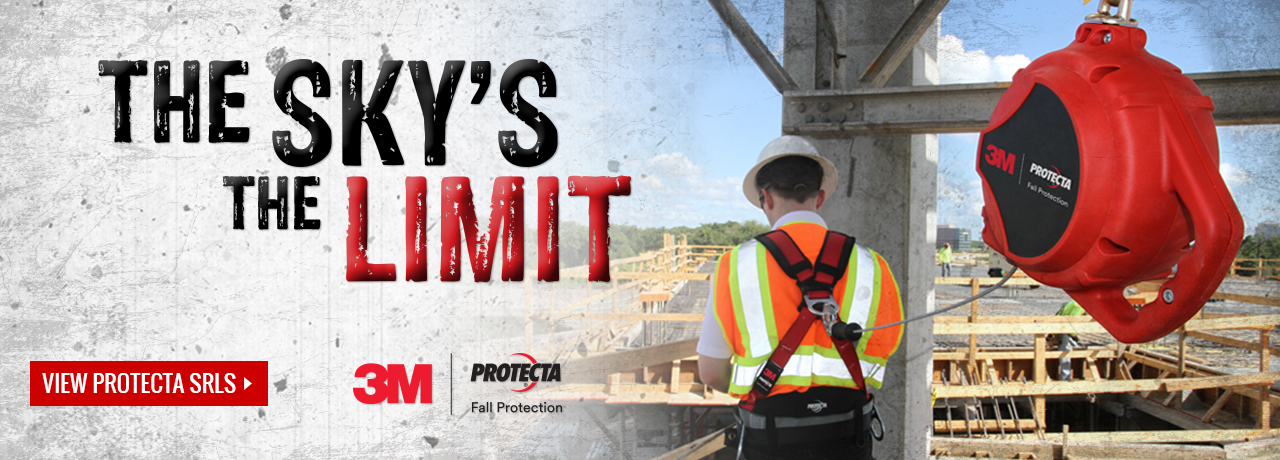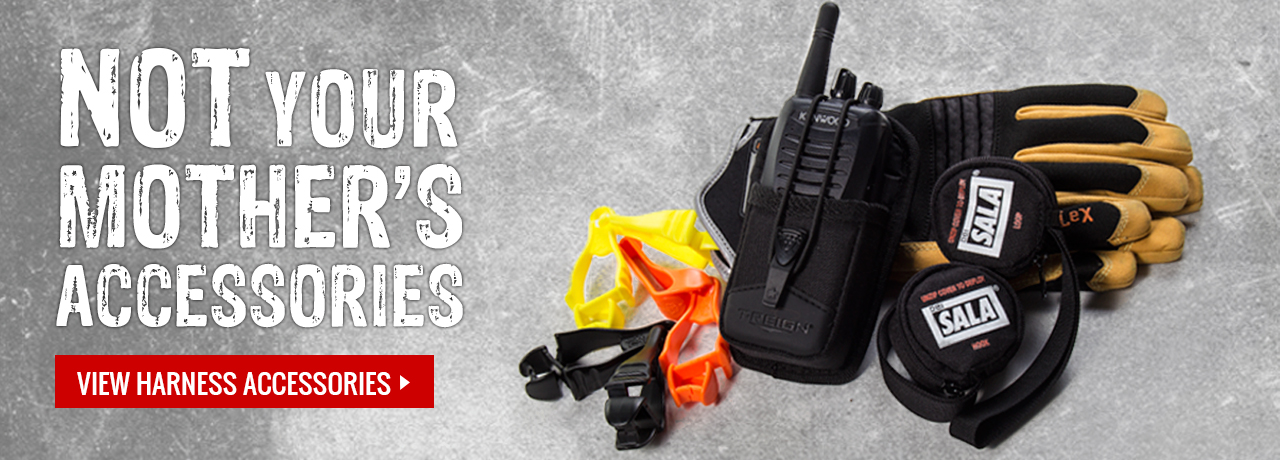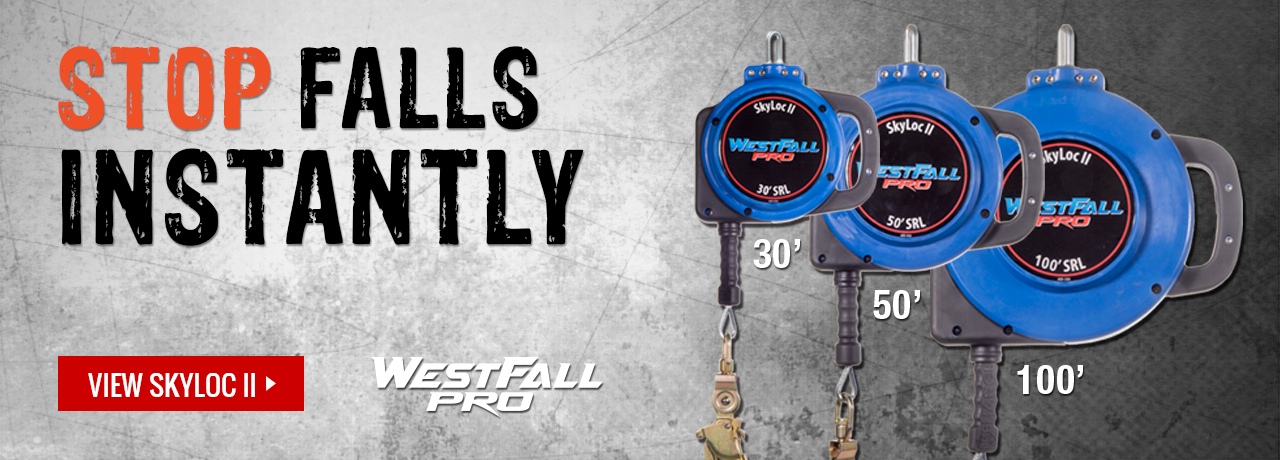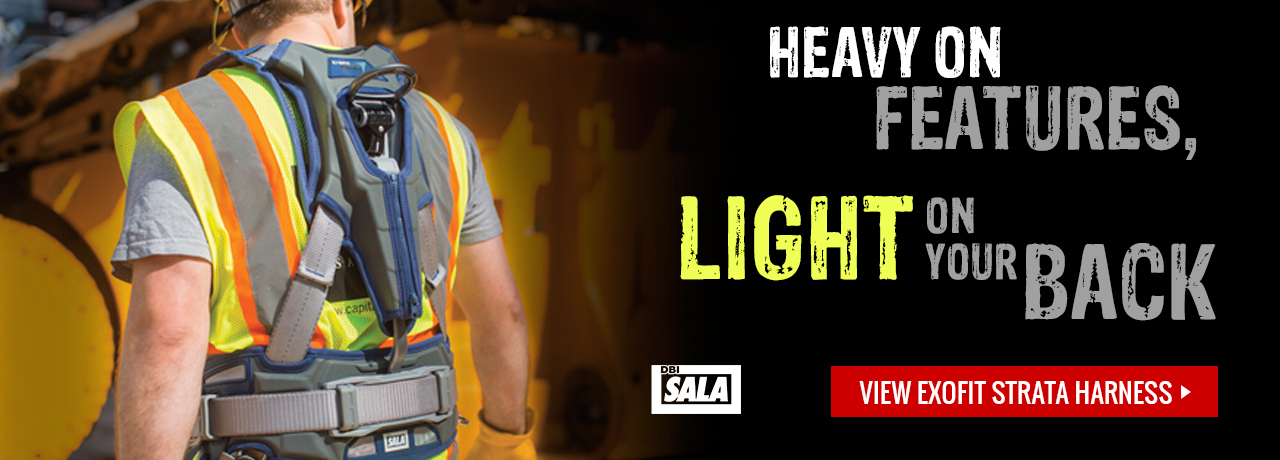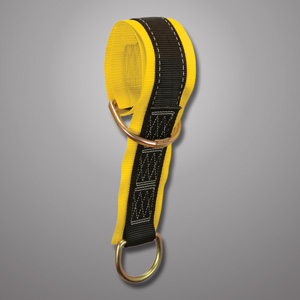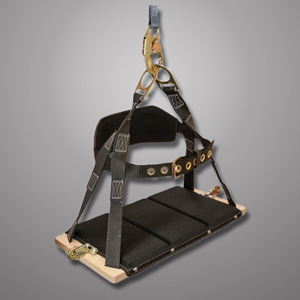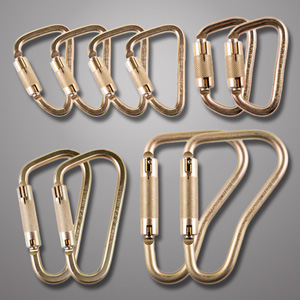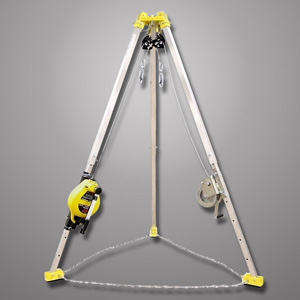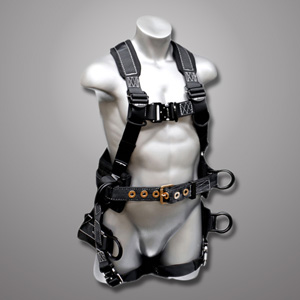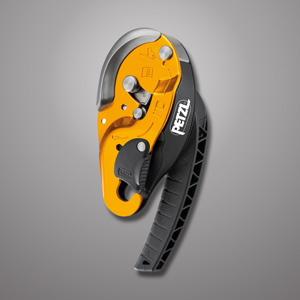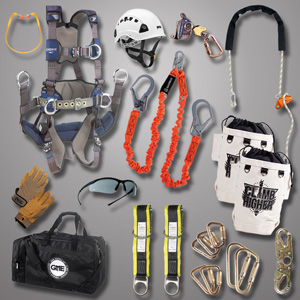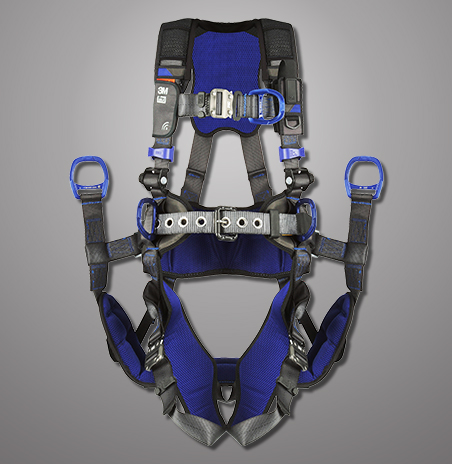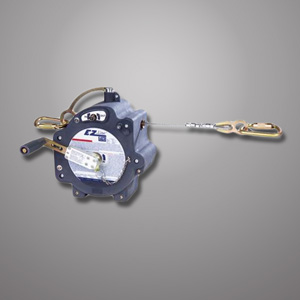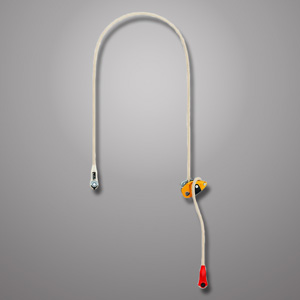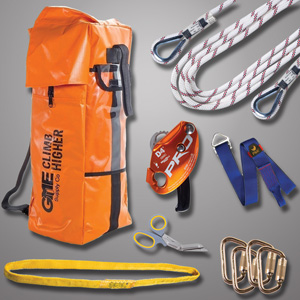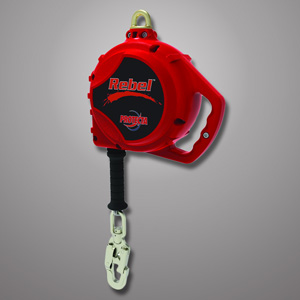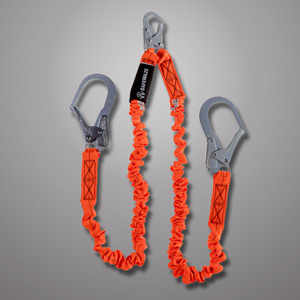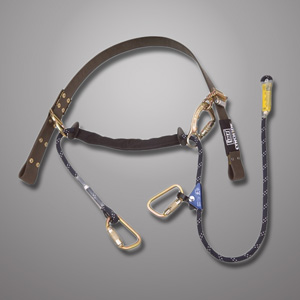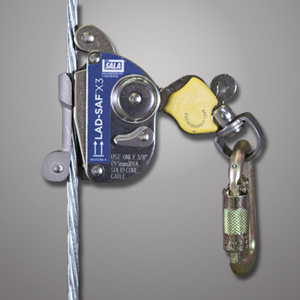YOU HAVE NO ITEMS IN YOUR CART.
Featured Brands
Fall Protection
Fall Protection Safety Gear & Equipment
Fall protection gear and equipment is equipment that is used to protect people working at-height from falling or in the event of a fall. You need fall protection to stay safe and compliant on the job site. GME Supply has all the fall protection you need for working at-height. Whether you are looking for an SRL, safety harness, lanyards, and/or anchorage we've got it.
The ideal method of fall prevention would be to eliminate all fall hazards from the workplace. However, this is seldom possible. Since many fall hazards cannot be eliminated, it is important to identify potential hazards before beginning a project. Whenever the possibility for a fall exists, a fall protection system must be used to ensure the safety of workers.
Personal fall protection equipment is divided into two broad categories: Fall Prevention (FP) equipment and Fall Arrest (FA) equipment. Workers must be provided with personal protective equipment appropriate to the application for which it is to be used. The term "personal" is used because the individual wearer is an integral part of the system and must be thoroughly trained in the proper use of the personal protective equipment. Many of our products may also be used in Positioning (PO), Suspension (SU), or Retrieval (RT) applications.
Fall Prevention (FP) may be accomplished either by eliminating the fall hazard or by using a tether system. The concept of a tether system is to prevent the worker from reaching a point where a fall can occur. The fall prevention system must be designed with extreme care because all possible hazards must be considered. (An example of multiple fall hazards would be roof work where at least two edges present fall hazards).
Fall Arrest (FA) is the least desirable method of fall protection, but it can quickly become the only available option. Despite all efforts to eliminate hazards and prevent falls, workplace falls continue to occur. To save lives and minimize injuries, we must be prepared with both the proper equipment and adequate training. A personal Fall Arrest (FA) system is required when working at heights of more than six feet.
Positioning (PO): products are designed to hold a worker in a safe working position while allowing free use of both hands. If the work is more than six feet above the surface a personal fall protection system designed for Fall Arrest (FA) may also be required.
Suspension (SU): products are designed to suspend the worker to allow them to perform work tasks such as window washing, exterior building maintenance, emergency rescue, and bridge work. Please, note that most Suspension (SU) situations will also require a Fall Arrest (FA) system.
Retrieval (RT): products are designed to permit the worker to enter an otherwise unreachable area, such as a confined space, or to assist in rescuing an injured or trapped person. Where these hazards exist, OSHA requires that both a rescue plan and a confined space plan be in place before work begins.
Ladder Climbing (LC): harnesses are equipped with a front D-ring that provides an attachment point to be used with either a rail or cable climbing system. Rail or cable climbing systems are found on fixed ladders, communication towers, electrical distribution towers and poles, and other structures.
Personal Fall Protection Equipment: Whether used for Fall Prevention (FP), Fall Arrest (FA), Positioning (PO), Suspension (SU), or Retrieval (RT), all fall protection systems consist of several essential components including an anchorage point, a connecting device, and appropriate body wear such as a full body harness, waist belt, or tree saddle.
Below we break down each category of fall protection gear, tips and tricks for finding the right gear, and some things to look for when picking your gear out.
Harnesses:
GME Supply knows fall protection. We have spent the last decade focusing on at-height industries and fall protection. One key component of fall protection is your safety harness. A safety harness not only needs to be functional, but comfortable as well. We offer a wide range of harnesses including harnesses with 1 to 6 D-rings, specialty harnesses, and harness accessories.
Some things to keep in mind when choosing your harness is what materials the hardware (D-rings and other connectors are made of). How many D-rings you need, connection points, and sizing, and certifications.
Materials: Any fall protection harness is going to feature aluminum or steel D-rings. Aluminum D-rings are lighter but more expensive. Steel D-rings, on the other hand, are cheaper but much heavier.
D-rings, Connection Points, and Sizing: The amount of D-rings you need will be dependent on your specific job requirements. You have 3 main options in connection points - tongue buckle, pass-through buckle, and quick connect buckle. Sizing varies depending on the manufacturer and we have a sizing chart reference guide to help you ensure that your harness will fit the way you need it to stay safe.
Certifications: When looking at full body harnesses it is important to keep in mind the certifications you need them to meet. If you are working in the United States you will need a harness that meets ANSI Z359.11-2014. ANSI Z359.11-2014 outlines the safety requirements for a full body harness. If you are working in Canada you will need a harness that meets the CSA requirements. Your CSA harness will need to meet the CSA Z259.10-12 Full Body Harness Standard.
Our selection of harnesses includes configurations from 1 to 6 D-rings, specialty harnesses and a range of different harness accessories.
Harness Accessories: Your harness is an intricate part of your fall protection set up. It is the apex of where all of your gear meets and without it, your gear cannot serve its purpose. Harness accessories help you take your harness to the next level. Our selection of harness accessories features phone and radio holsters, strap cushion pads, lanyard parks, D-ring extenders, safety devices, trauma safety straps, badge holders, and more.
Specialty Harnesses: Not all jobs are created equal. And because of that, not all harness are created equal, either. At GME Supply we pride ourselves in being America’s premier outfitter of fall protection and that’s why we carry a line of specialty harnesses. Specialty harnesses are designed to not only provide the same fall protection that regular harnesses do but to also provide added protection for certain hazards. Our specialty harnesses include arborist harnesses, arc flash harnesses, and hi-vis harnesses.
Shock Absorbing Lanyards:
Shock absorbing lanyards are a staple of any fall protection setup. With an extensive background in fall protection and a mission of keeping workers safe while on the job, GME Supply has got you covered when it comes to shock absorbing lanyards. We feature two styles of shock absorbing lanyards: single leg lanyards and twin leg lanyards. Both our selection of single leg and twin leg lanyards have a variety of options including foot level tie off, tie-back options, and 6 & 12 foot lengths.
Single Leg Lanyards: Our selection of single leg lanyards is diverse. Whether you are looking for a specific length, connector style, or need one for a specific application, we’ve got you covered. Our single leg shock absorbing lanyards feature an internal shock absorber that dissipates the energy of a fall - putting less stress on your body and preventing serious injury.
Twin Leg Lanyards: Like our single leg lanyards our selection of twin leg lanyards is diverse. So, whether you are looking for a specific length, connector style, or need one for a specific application, we’ve got you covered.
Carabiners & Hardware:
When it comes to fall protection the carabiners and hardware you choose are extremely important. When your life's on the line you want to know that the gear you are using is top quality. Our Gear Experts® [insert link here] have spent years sourcing the best hardware. From carabiners and connector packages to spreader bars, snap hooks, rebar hooks, and positioning assemblies our selection of carabiners and hardware have you covered no matter what job you’ve got coming.
Which carabiner is right for you? Let’s outline the carabiner features so you can pick the best hardware for the job. First, we are going to look at ANSI standards. The ANSI Z359.12-2009 standard for carabiners requires that a carabiners major access point have a strength of 5,000 pounds. The gate face, sideload, and minor access strength must be at least 3,600 pounds.
Next, we will outline the different carabiner gate mechanisms. The three main styles are screw-lock, twist-lock, and auto-lock.
Screw-Lock: The screw-lock operates by unscrewing the sleeve down the gate to open. This gate will not auto-lock, as the sleeve has to be manually tightened after the gate snaps shut.
Twist-Lock: The twist-lock is a double action gate that quickly opens with a simple twist and pull movement.
Auto-Lock: The auto-lock is a three-stage design as it requires 3 different motions to open. First, you pull the sleeve down, then twist, then pull back to open. Some carabiners only twist one direction, while others can twist left or right.
For more information on how carabiner gate mechanisms work check out our knowledge base.
Our fall protection hardware selection includes separator bars, snap hooks, and rebar hooks.
Let’s start by looking at certifications. Like carabiners, snaphooks, rebar hooks, and separator bars must meet the ANSI Z359.12-2009 standard. This standard requires that the major access point must have a strength of 5,000 pounds. The gate face, sideload, and minor access strength must be at least 3,600 pounds.
Separator bars are great for positioning and providing relief on the hips and waist during a long day of climbing. Snaphooks and rebar hooks server similar purposes to carabiners and come in a range of different sizes. Which of these devices is right for you? That depends on the job at hand.
Anchorage
GME Supply is your source for permanent and temporary anchorage solutions. Fall protection gear is our specialty and your safety is our priority. That’s why we offer a full selection of different anchorage solutions.
Anchors provide secure attachment points for workers. There are many different ways to properly anchor depending on the job and structure. No matter what solution you choose be sure to look for anchorage points that are rated for at least 5,000 pounds or even an engineered solution designed for your specific application. Our selection of anchors includes concrete anchors, general anchors, roof anchors, sling anchors, specialty anchors, and steel anchors so that no matter what the job at hand is, we can help you get it done efficiently and safely.
Concrete Anchors: Concrete anchors are so named because they are designed to be used on concrete. Our concrete anchor selection includes wedge anchors, bolt anchors, anchor straps, parapet anchors, and pour-in-place anchors.
General Anchors: Our general anchorage section includes a wide range of different anchors. From cable and truss to plates, slings, and window gap anchors, GME Supply has got you covered when it comes to general use anchors.
Roof Anchors: Roof anchors got their name from the fact that they are especially suited to be used on roofs. Our roof anchor selection features something for any job that comes your way. We’ve got reusable, disposable, and permanent anchors along with a wide variety of styles, sizes, and options including hinged anchors, freestanding counterweight anchors, fall arrest posts, and SRL anchors.
Sling Anchors: Our sling anchor selection includes both web and cable anchors in a range of lengths, widths, and configurations. No matter what type of sling anchor you’re looking for we’ve got you covered.
Specialty Anchors: Some jobs require unusual anchorage solutions. Here at GME Supply, we’ve put together a selection of specialty anchors that help you get those unusual jobs done while staying safe. From sliding rales and window/door anchors to parapet wall anchors, tripods, and vacuum anchors we’ve got everything that special job requires.
Steel Anchors: When working at-height you deal with a lot of steel. Being able to attach an anchor to that steel is still an import part of your gear setup. Steel anchors have been specifically designed for use with steel structures. Our steel anchor selection features plate anchors, brackets, beam anchors (both trailing and fixed), wall anchors, and weld on anchors.
Vertical Systems
Vertical systems are an intricate part of fall protection. Whether you are looking for cable safety sleeves (cable grabs), ladder safety (like a cable climb system) rope grabs, or lifelines, GME Supply is your source for all things vertical systems related.
Cable Safety Sleeves: Your cable safety sleeve (also called a cable grab) is the second component of your fall protection rig. It should be attached to a rigid anchorage line (like a safe climb ladder system) to secure you while moving up or down on the wind turbine. We feature two main types of cable safety sleeves: traditional (manual), and trailing.
A traditional cable safety sleeve also referred to as a manual cable safety sleeve, will not move on the lifeline. You have to move it as you climb up, hence the “manual” portion of the name. Trailing cable safety sleeves, on the other hand, can move up and down your lifeline freely (trailing you). This type of cable safety sleeve is typically more convenient and poses fewer hazards than a manual cable safety sleeve.
Ladder Safety: Fall protection is an important aspect of at-height work. In many industries (like solar and telecom) cable climb systems have become the norm. A cable climb system increases safety and reduces the risk of a fatal fall. These cable climb systems are technically ladders which is why they are considered ladder safety. A ladder safety fall protection system, better known as a cable climb system, is pre-installed on a structure and features a cable attached to the ladder. You can use a cable grab attached to your sternal D-ring to move up and down the ladder with ease. In the event of a fall, the cable safety sleeve will lock onto the cable and arrest the fall. Applications for ladder fall protection systems include towers, billboards, commercial buildings, utility, solar, and wind.
We offer a full line of Tuf-Tug and 3M cable climb systems that come in a variety of designs and sizes. The monopole system is available in standard lengths of 100’, 150’, 200’, and 250’. The fixed ladder system is available in standard lengths of 100’, 200’, 250’, 300’, and 400’. And, the round climbing leg system is available in standard lengths of 150’, 200’, 250’, and 300’.
These systems can be further customized. Contact our Gear Experts® for more information about customization.
Rope Grabs: You’ve got a lifeline, but now you need a way to make sure you are secured to it. That’s where rope grabs come in. Rope grabs are fall arrest devices that travel up and down a vertical lifeline and are extremely convenient and easy to use. They provide 100% tie off by staying attached to your lifeline and moving up and down with you as you ascend or descend. These little devices work by latching onto the rope when they sense a fall preventing you from getting injured. Not to mention, they save a ton of time because you don’t have to stop every few feet to reattach your lanyard as you climb.
Rope Lifelines: When it comes to any at-height industry, fall protection is an important part of the job. Not to mention you will probably spend some time in situations where tying off to an appropriate anchor can be difficult. That's why having the best lifeline is important. Our gear experts have spent years sourcing the best lifeline rope available and our hand-picked selection will help you stay safe and get the job done. We feature a range of styles, colors, lengths, and sizes of rope. You can choose a rope from 300, 600, or 1,200 foot pre-cut lengths, or if you need a custom length rope - we’ve got you covered there too. Diameters include ?, 7/16, ?, and ½ inch options and come in a variety of styles including HTP static, 3-strand, and unicore. We’ve also got a range of colors so that each lifeline can be visibly different than the others for easy identification.
Self-Retracting Lifelines
No one wants to think about falling while on the job. But, sometimes accidents happen. It is up to us to make sure that in the event of a fall there are safety measures in place to ensure that everyone stays as safe as possible. That’s where an SRL comes into play. A Self-Retracting Lifeline, or SRL, is a device that contains a spring-loaded retracting web or cable lanyard wound around an internal drum. It automatically locks and arrests the fall of a worker.
When looking at SRLs it is important to understand the standards that they need to meet. ANSI Z359.14-2012 classifies SRLs into two classes - Class A and Class B. For more information about SRL standards click here for our blog post or here to visit our knowledge base.
Our full selection of SRLs includes body worn, mounted, leading edge, arc flash, and rescue SRLs.
Body Worn SRLs: A body worn SRL is a more compact version of a mounted SRL and works in the exact same way. The key differences are that it is smaller, lighter, and connects directly to the dorsal D-ring on your harness. Body Worn SRLs have shorter lifelines that most commonly range from 6 to 8 feet and do not exceed 8 feet in length. Another unique thing about body worn SRLs is the ability to have a twin leg configuration to provide 100% tie-off.
Mounted SRLs: Larger SRLs are mounted above the worker, and the lanyard runs down to connect to the user’s dorsal D-ring on their harness. Mounted SRLs are typically heavier and come in lengths ranging from 8 ft to over 100 ft.
Leading Edge & Foot Level SRLs: Most SRLs are designed only to be mounted above the user. For cases where this is not possible, specially designed Leading Edge SRLs (sometimes referred to as Foot Level SRLs) are required. ANSI classifies these as SRL-LE devices. These incorporate factors to absorb the extra energy associated with foot-level tie off, as well as more robust cables to resist breaking when ran against a leading edge. Leading Edge SRLs come in both mounted and body worn options so you can get the perfect SRL no matter what.
Arc Flash SRLs: Just like with everything in life, there are special SRLs that have been specifically designed for unique situations. Arc Flash SRLs are SRLs that have been rated for working in electrical environments. Whether you need mounted, body worn, or twin leg variations for 100% tie-off, we’ve got the Arc Flash rated SRLs to help you get the job done and stay safe.
Rescue SRLs: In a perfect world, there would be no accidents. Unfortunately, we don’t live in a perfect world and whether we like it or not accidents do happen. But, being prepared can help prevent further injury. Rescuing a co-worker isn’t always easy, especially if they are in hard to reach places. That’s where rescue SRLs come in handy. Typically rescue SRLs, referred to as SRL-R by ANSI, for auto retrieval can be found on confined space systems.
Designing a Fall Protection System
The following generally accepted elements of fall arrest must be considered in designing a fall protection system:
A rescue plan should be in place prior to beginning any work where a fall hazard exists. The rescue plan must be well thought out, and all individuals involved must thoroughly understand the rescue plan.
If a fall hazard exists, the worker should wear a full body harness that distributes the arresting force of a fall arrest over the buttocks, hips, and shoulders. For Fall Arrest (FA) applications, the attachment point of the connecting device to the harness should be in the center of the back between the shoulder blades. The potential free-fall distance should be as short as possible and must be calculated to prevent contact with the nearest surface or obstacle below. (OSHA mandates limiting free-fall distance to six feet or less.)
The shock load or arresting force of a fall arrest should be less than 1,800 pounds.
After a fall arrest, the fallen worker should be held securely by their fall arrest system in as upright a position as possible while awaiting rescue. This will not only make them more comfortable and minimize further injury but will also facilitate the rescue efforts.
At GME Supply, we make every effort to provide the very best quality fall protection equipment, but it is designed to be used only by trained workers. It is the employer's responsibility to provide his or her employees with both the proper fall protection equipment and sufficient training to wear and use the equipment safely.
If you have any questions about the proper use of our complete line of Fall Protection Equipment click here to contact one of our Gear Experts®.
